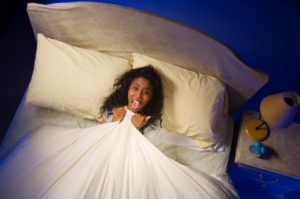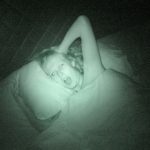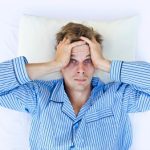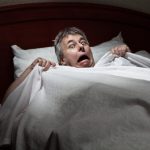 There are a lot of unknowns and speculations when it comes to sleep paralysis, Halloween myths, hallucinations, visions and lucid dreaming. Much of it seems like old wives’ tales, but how do you distinguish between what is real and what is simply a myth?
There are a lot of unknowns and speculations when it comes to sleep paralysis, Halloween myths, hallucinations, visions and lucid dreaming. Much of it seems like old wives’ tales, but how do you distinguish between what is real and what is simply a myth?
Sleep paralysis, when explained by someone who has encountered it, sounds like something straight out of a horror film. Maybe people describe seeing a figure – or demon – over their chest holding them down and preventing them from moving or even screaming. Symptoms such as feeling as if someone is sitting on your chest or feeling a cloud of evil coming toward you are both characteristics of sleep paralysis. And if it sounds like a horrid nightmare, that’s because it truly is – but a nightmare you can’t simply wake up from.
Advertisement
Furthermore, around the time of Halloween we hear more stories about hallucinations or visions, but it’s important to note these are two different concepts. Hallucinations are when you “see” something that isn’t there, while visions are more like premonitions
Even if they’re not a believer of spirits and ghosts, many people find it hard to deny or brush off the many encounters people have when they experience sleep paralysis.
Myths and facts of sleep paralysis
When it comes to sleep paralysis there are many science-based facts but, at the same time, a lot of myths surround the phenomenon. Around the world sleep paralysis goes by many names. For example, in Newfoundland they refer to it as “the old hag” who visits at night. In China, it’s known as “ghost oppression,” and some art has even depicted figures sitting on top of people while they attempt to sleep.
What a person may see during their sleep paralysis is dependant on their own experience. For example, after alien flying saucers became popular, many individuals reported that aliens probed them at night. In Mexico, the phrase, “a dead body climbed on top of me” is quite popular and well-understood.
It doesn’t matter where you come from, it appears that each unique place in the world has their own rendition of sleep paralysis based on cultural and historical beliefs.
Hallucinations and visions during sleep paralysis
 Roughly one in five individuals who experiences sleep paralysis will also experience hallucinations or visions. Common hallucinations include seeing demons, ghosts, even witches and thieves who speak to the individual and threaten them. This can be quite horrifying and prevent the individual from going back to sleep. It’s easy to create a supernatural link to tie hallucinations and sleep paralysis, but science does have a say on the two.
Roughly one in five individuals who experiences sleep paralysis will also experience hallucinations or visions. Common hallucinations include seeing demons, ghosts, even witches and thieves who speak to the individual and threaten them. This can be quite horrifying and prevent the individual from going back to sleep. It’s easy to create a supernatural link to tie hallucinations and sleep paralysis, but science does have a say on the two.
Because sleep paralysis is so tightly linked with the REM sleep phase – this is the phase where our dreaming occurs – being awake during REM may intrude on that sleep phase, so we begin to see our dreams. This is where the paralysis comes from – even though our eyes are open we are unable to move or speak, so essentially our bodies are still asleep.
Even though a lot is still unknown about sleep paralysis, the above may further explain the hallucinations and visions which are experienced.
Types of sleep paralysis hallucinations
There are four main types of sleep paralysis hallucination: hallucinations or sensed presence, incubus hallucinations or old hag, unusual bodily experiences or vestibular-motor hallucinations, and mixed hallucinations.
 Hallucinations or sensed presence: The person may hear voices, sense a presence in the room or close by, and see visual hallucinations.
Hallucinations or sensed presence: The person may hear voices, sense a presence in the room or close by, and see visual hallucinations.
Incubus hallucinations or old hag: The person feels pressure on their body, has trouble breathing, feels pain, feels suffocated, and feels like they are being threatened or are going to die.
Unusual bodily experiences or vestibular-motor hallucinations: The person experiences feelings of happiness or content, their body may feel like it is moving or flying, they have feelings of lightheadedness and out of body experiences.
Mixed hallucinations: Hallucinations that encompass two or more of the other types of hallucination.
Sleep paralysis and lucid dreaming
Lucid dreamers will actually induce sleep paralysis to experience their dreams. Lucid dreaming gives the dreamer control and allows them to be active inside the dream.
Advertisement
The main difference between sleep paralysis and lucid dreaming is that in sleep paralysis you become a hostage in your own body with the inability to move or control what is going on. In lucid dreaming your eyes are still closed and you can control your dreams, causing a much more pleasant experience.
Causes of sleep paralysis
As mentioned, sleep paralysis is still a large mystery, but there are some theorized causes which may bring it about. Causes of sleep paralysis include:
- Lack of sleep

- Changes in sleep
- Mental disorders
- Sleeping on your back increases the odds of sleep paralysis
- Other sleep disorders like narcolepsy
- Use of certain medications
- Substance abuse
How to prevent sleep paralysis
Here are six easy steps to help you stop sleep paralysis.
- 1. Relax your body into the paralysis – trying to fight it will increase panic and anxiety.
- 2. Attempt to gently wiggle your fingers and toes.
- 3. Try to move your eyes by blinking or looking elsewhere around the room.
- 4. Try to move your lips or mouth.
- 5. Focus your attention on breathing.
- 6. Try to remain calm and positive.
